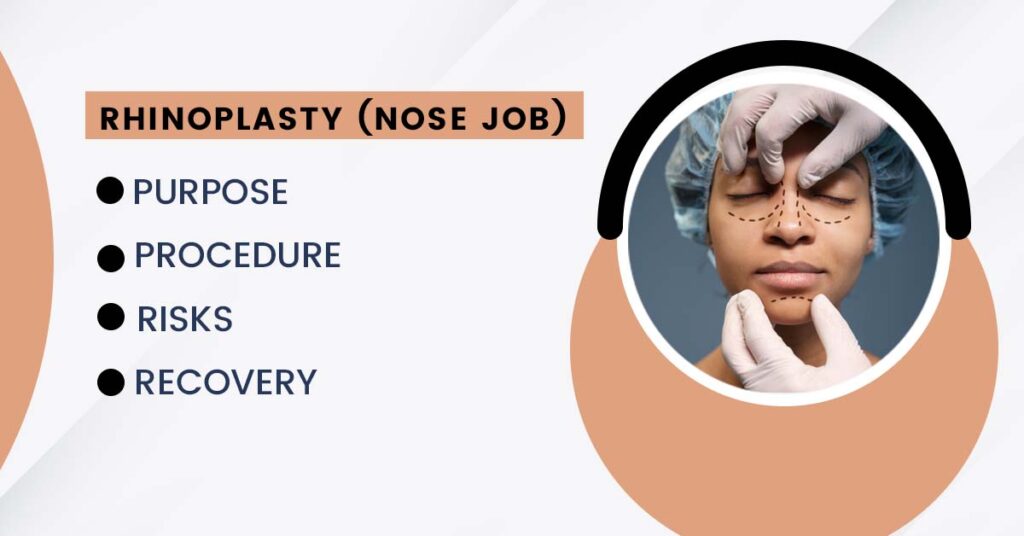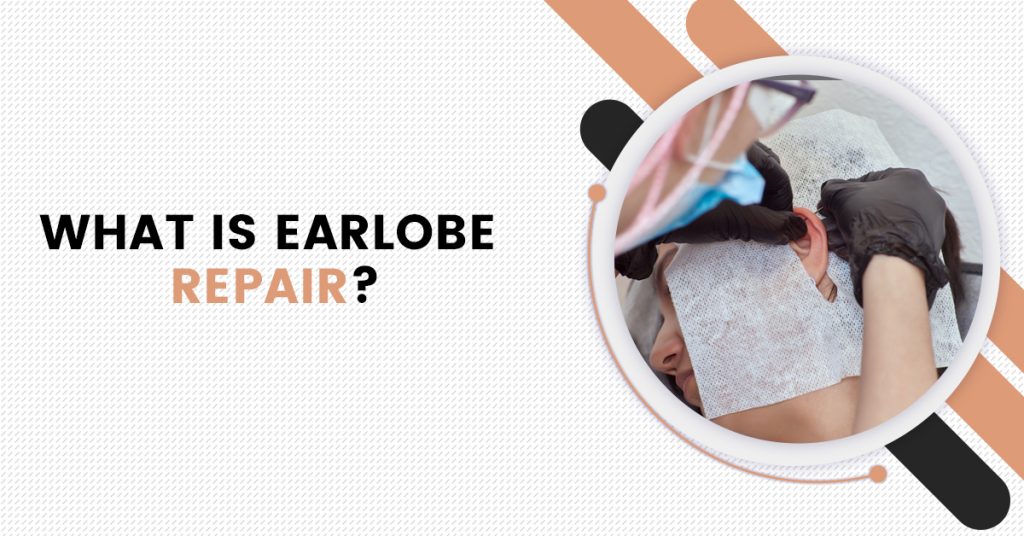What is Rhinoplasty?
Surgically modifying the nose’s shape is known as a rhinoplasty. There are several reasons for undergoing a rhinoplasty procedure, including altering the look of the nose, enhancing breathing, or both. The nose’s structure is composed of cartilage at the bottom and bone at the top.
Bone, cartilage, skin, or all three might be changed during rhinoplasty. Discuss the benefits of rhinoplasty and whether it is right for you with your surgeon. Rhinoplasty will be planned according to your other facial features, skin on your nose, and desired changes.
Reasons for Rhinoplasty
People may get rhinoplasty to:
- Make good on a birth defect.
- Boost the appearance as a whole.
- Damage to the septum, the bone and cartilage that divides the nostrils, results in
open blocked nasal passageways (deviated septum).
- Make good on a facial fracture, such as a broken nose.
- regain respiratory ability following burns, traumatic injuries, or cancer treatments.
Risks of Rhinoplasty
In addition to the risks associated with all forms of surgery (bleeding, infection, loss of feeling, and anaesthetic hazards), nose surgery risks also include:
- Asymmetry: Due to the complexity and level of specialised skill required for nose surgery, the results may not be perfectly symmetrical.
- Runny or dry nose: Surgery may alter how the nasal airways work and result in unpleasant feelings.
In addition, but not only, but there are also additional potential dangers associated with rhinoplasty
- breathing through your nose is challenging.
- Numbness that lasts forever in and around your nose
- the potential for a nose that looks uneven
- persistent pain, discolouration, or edema
- Scarring
- There is a septal hole (septal perforation)
- a requirement for more operations
You can Read Also: Hair Transplant: Procedure, Recovery, Complications, and More
How should we prepare for rhinoplasty?
Before scheduling an appointment for rhinoplasty, you should discuss this with your surgeon.
This gathering often consists of:
- your medical background. In most cases, your doctor will ask you about the purpose and goals of your surgery. In addition to contacting your doctor about your medical history, the doctor will also ask about any operations you have had, nasal obstructions you have, and medications you may be taking. You might not be a candidate for rhinoplasty if you have a blood problem like haemophilia.
- a medical checkup. Your doctor will do a complete physical examination, including any required laboratory tests, such as blood work. He or she will examine your facial features, as well as the inside and outside of your nose.
The physical evaluation helps your doctor decide what adjustments are required and how physical traits, like the thickness of your skin or the resilience of the cartilage at the tip of your nose, may affect the outcome. Your ability to breathe will be impacted by rhinoplasty following the findings of the physical examination.
- Your doctor’s office will take pictures of your nose from various perspectives. To demonstrate the types of outcomes that are possible, your surgeon may modify the photographs using computer software. These images will be used by your doctor for long-term evaluations, reference during surgery, and before-and-after evaluations. Most significantly, the pictures provide a detailed description of the surgery’s objectives.
- an examination of your hopes. Your doctor should know what you hope to accomplish and what you expect. He or she will go over what rhinoplasty can and cannot do for you, as well as potential outcomes. Although it’s common to have some self-consciousness when talking about your appearance, you must be honest with your surgeon about your wishes and surgical goals.
Your surgeon might discuss chin augmentation surgery with you if you have a small chin. This small chin will give the appearance of a larger nose. There are some situations in which chin surgery may not be required, but it might be beneficial for balancing the facial profile better.
Procedure of Rhinoplasty
To remodel the cartilage and bone in your nose, your surgeon will conduct rhinoplasty by creating an incision either inside or just outside of your nostrils. Your surgeon will probably remove some of the cartilage in your nose and replace it with cartilage from elsewhere in your nose, or less frequently, from your ear or rib, to surgically reshape your nose. Rhinoplasty procedures are carried done by surgeons either in their office, a hospital, or an outpatient surgical facility.
One of the following techniques will be used by your surgeon when performing rhinoplasty:
- By inserting specialised devices through minute incisions in the nose, minimally invasive surgery is carried out. Compared to open surgery, minimally invasive surgery typically has a quicker recovery and less pain. This is a result of decreased tissue stress. Instead of the bigger incisions utilised in open surgery, your surgeon will use a smaller one. Instead of chopping through or shifting bone and cartilage as in open surgery, he or she can then thread surgical instruments around them.
- The columella, the tissue strip between the nostrils and above the upper lip, is the site of open surgery. Your surgeon can see and access the operative area more easily with an open surgery incision. Compared to minimally invasive surgery, open surgery typically has a longer recovery period and more discomfort. This is a result of increased tissue stress. Compared to minimally invasive surgery, open surgery necessitates a wider incision and greater cutting and tissue displacement. Despite this, some patients may find open surgery to be a safer or more efficient procedure.
Your surgeon might occasionally perform both open surgery and minimally invasive treatment. Additionally, your surgeon can determine that you need open surgery to finish your surgery safely and most efficiently after starting a minimally invasive technique.
Recovery from Rhinoplasty
After your nose surgery, take a full week off of work or school to recover. Within a week, the external splint is taken off. If packing was utilised during surgery, it was typically removed one or occasionally two days later.
The majority of daily activities can be resumed after two weeks, but you should wait six weeks or until your surgeon indicates it’s safe before engaging in strenuous exercise or playing contact sports. During the early stages after recuperation, refrain from sexual activity since this could speed up bleeding if coagulated blood vessels reopen.
Healing
The first week after having a nose surgery should be filled with swelling and bruises. The majority of the time, post-operative pain is manageable, but it will help if you follow your doctor’s advice to relax, ice your nose, and take painkillers as directed.
During the initial healing period following surgery, you should:
- Put cool compresses (not ice) under your eyes or on your cheeks (not directly on the nose).
- Avoid any contact with your face.
- Wearing eyeglasses or sunglasses should not put undue pressure on the nose’s bridge.
- Particularly when sleeping, keep your head raised.
- Limit your time in the sun.
- Avoid blowing your nose.
- not lift any heavy objects.
- Utilize over-the-counter painkillers.
You can Read Also: Earlobe Repair – Causes of Earlobe, Risk Factors, Cost, and Procedure
Coping With Recovery
Within a month following your nose surgery, you’ll have a good notion of your outcomes, but it won’t be clear how you’ll look in the end until you’ve had a full year to heal. 3 While you might be tempted to evaluate the results of your nose surgery straight away, try to hold off until the swelling has completely gone down.
It’s crucial to have patience while recovering after surgery. While you should allow yourself plenty of time to rest, you should also make an effort to fill your day with interesting activities that will keep your mind active.
Results of Rhinoplasty
Changes to your nose’s structure that are commonly measured in millimetres can have a significant impact on how your nose appears. A skilled surgeon can typically provide outcomes that both of you are happy with. However, in certain instances, the small adjustments are insufficient, and you and your surgeon can opt to do a second surgery for more adjustments. If so, you will need to wait at least a year before having the follow-up surgery because your nose may change during that time.
Although rhinoplasty is a generally safe and simple technique, recovery time can be extended. Your nose’s tip is particularly delicate and might stay numb and swollen for months. Although you might feel completely well in a few weeks, certain side effects can last for months. Before you can fully appreciate the outcome of your operation, it could take up to a year.







